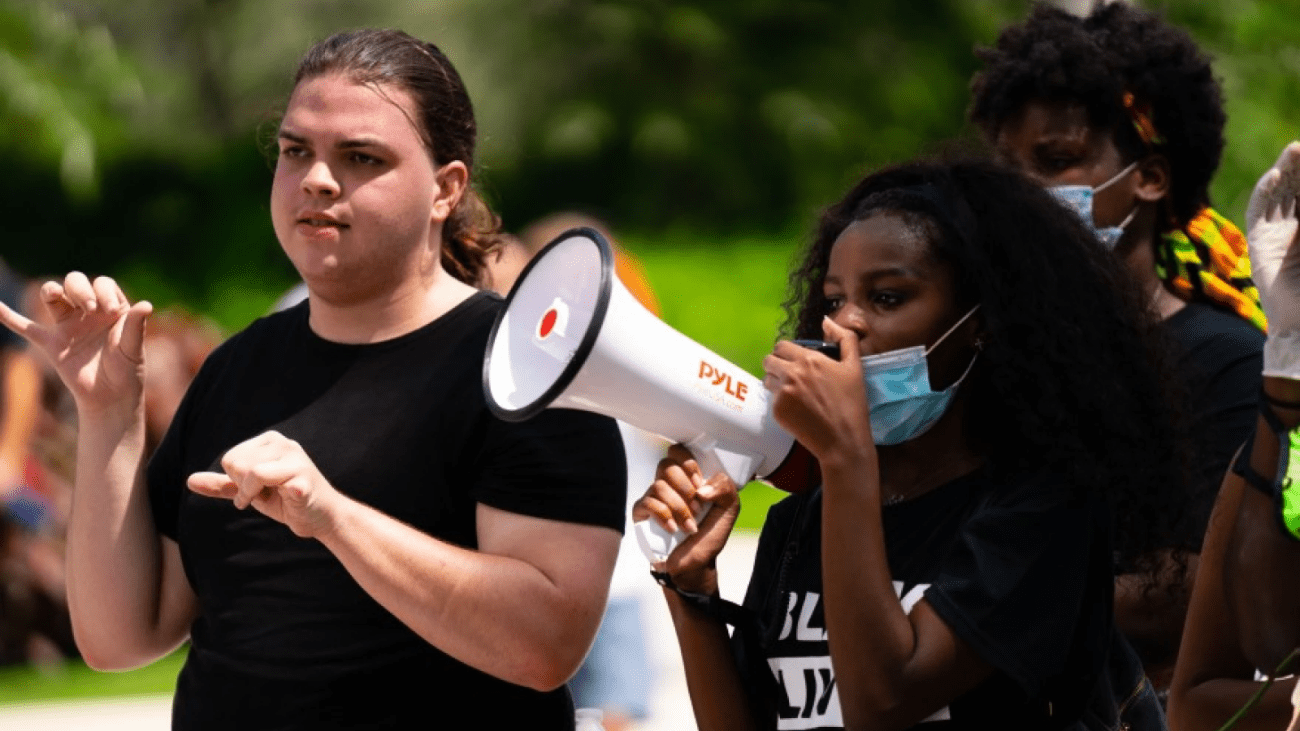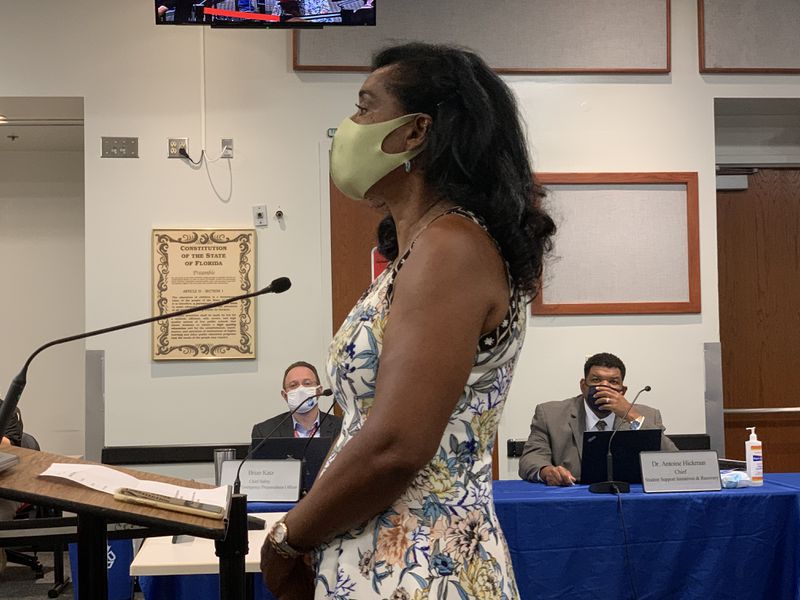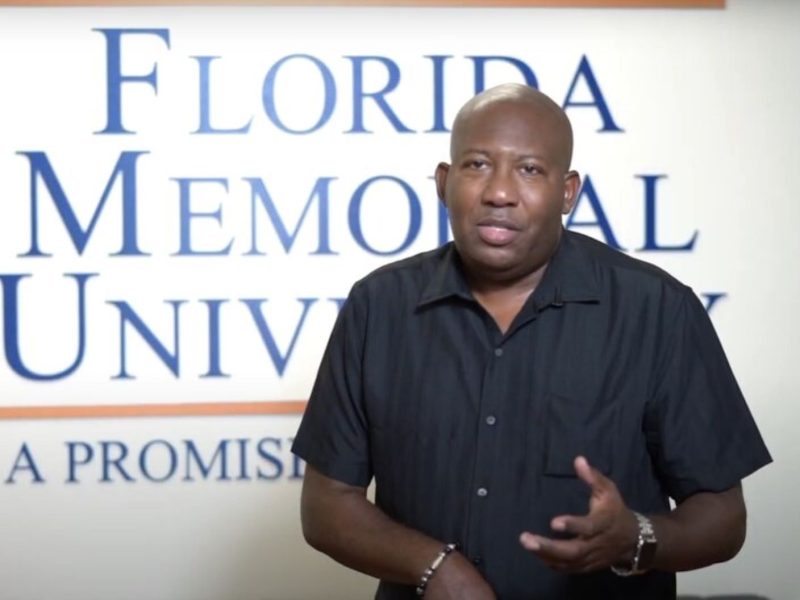Twice As Many Police Officers In Florida Schools. Some Student Activists Want Them Out
WLRN | by Jessica Bateman | September 2, 2020
Nine days after 17 people were killed at Marjory Stoneman Douglas High School, Broward Schools Superintendent Robert Runcie stood in front of the Parkland campus and told reporters there would be a new security measure in place when the school reopened.
Then-Sheriff Scott Israel “has introduced automatic rifles for school resource officers on school grounds,” Runcie said, indicating that he wasn’t exactly thrilled about it.
“It is short-term. It’s interim … a stopgap measure to create a heightened sense of security around the district,” Runcie said during the event on Feb. 23, 2018.
A heightened sense of security. But, for whom?
That’s a question many students are asking now about armed police on school campuses. Many Black kids say the presence of law enforcement officers makes them feel less safe.

Olivia was a freshman at Cypress Bay High School in Weston that year. The school is less than 4 percent Black.
“It was right after MSD had happened,” Olivia said, referring to the Parkland shooting, “and … they had more officers in almost all the schools. And everyone was so happy about it. … They were like, ‘Yes! I can feel safe going to school.’
“And I remember walking off the bus and seeing these three men gathered together with AR-15s in their hands,” she said. “I looked over, and he looked right at me. And the way he stared at me was terrifying. He looked like I was a threat. I didn’t feel like a person anymore. All he was seeing was my skin. It just hurt so much …. to be seen like this, just because I’m Black.”
Olivia is 17 now. After participating in Black Lives Matter protests this spring, she has been harassed and threatened on social media, so she asked WLRN not to use her last name.
Seeing police officers kill Black people over and over again affects how Olivia feels about herself, about her education, about her future.
“Imagine how that feels, to feel worthless almost. To feel like, no matter what I do, no matter how hard I study, no matter how many good grades I get, one day someone can just kill me and get away with it and nothing will happen,” she said. “That’s what it’s like to be Black.”
Since a white police officer killed George Floyd in Minneapolis, and protesters filled the streets in historic uprisings, major school districts throughout the country have voted to get police out of schools: Minneapolis, St. Paul, San Francisco, Oakland, Seattle, Portland, Denver, and some schools in Chicago.
Student activists in South Florida want the same thing to happen here. But they face what could be an insurmountable challenge: Parkland. Shortly after the massacre two and half years ago, Florida passed a law requiring a police officer or armed guard on every campus.
A new report from the University of Florida found the number of police on school campuses statewide nearly doubled since the Parkland shooting — and with that big jump in officers came a big jump in arrests at school.
The law is an obstacle. Still, students here are pushing for whatever they can get — even if it’s just pulling some funding away from police and using it instead to hire more teachers, social workers and counselors.

The consequences of Parkland-inspired policy changes for Black students
A study released Wednesday — that was conducted by a top education researcher at UF — found a near doubling of the number of police stationed at Florida schools since the Parkland shooting, with the increase driven largely by new officers at elementary schools. Arrests at schools jumped from 40 to 82 percent, the report found.
The higher presence of police officers at schools also resulted in more student disciplinary infractions being reported to law enforcement, “particularly for less severe infractions and among middle schoolers,” according to the report.
“There was little consistent evidence that the presence of law enforcement decreased the number of behavioral incidents occurring, indicating that school-based law enforcement were not necessarily making schools safer,” wrote the report’s author, F. Chris Curran, director of UF’s Education Policy Research Center. He is white.
“While I think it’s important that we obviously do work to ensure that another tragedy like Parkland never happens, the research is fairly clear that putting armed individuals in schools is not necessarily a solution,” Curran said during an interview with WLRN.
“There are a lot of implications of the study that suggest that we should have some real concerns about the potential tradeoffs that come with putting law enforcement in schools as a safety mechanism and the type of implications that may have on students’ trajectories into the law enforcement system, and eventually, the school-to-prison pipeline,” he said.
Several incidents involving police and Black children in recent years illustrate student activists’ and researchers’ concerns.
Earlier this year, a cell phone video surfaced showing a Miami-Dade school resource officer threatening to shoot a group of Black students while placing her hand on her gun. Also, in Orlando, a cop stationed at a charter school was fired after arresting a 6-year-old Black girl — an incident that went viral nationally and sparked an unsuccessful effort to pass a state law setting a minimum age for arrest.
Olivia, her friends, and fellow student activists in Weston pointed to another arrest of a Black teenager last year to demonstrate why Black kids don’t believe police are there to protect them.
Broward Sheriff’s Office deputies were caught on video violently arresting DeLucca Rolle, a then-15-year-old Black student at J.P. Taravella High School. Police had been called to break up a fight in the parking lot of a McDonald’s near the school where students often hang out in the afternoons waiting to get picked up.
Officers pepper sprayed Rolle, punched him and repeatedly slammed his head into the pavement, fracturing his nose. Two deputies now face misdemeanor battery charges.
“That’s why we don’t want police in schools, because they’re just another way of white supremacy sneaking into the schools and breaking our students down,” Olivia said.
Olivia’s classmates and fellow Black activists, Joy and Ameerah, both 17, also faced online threats, so WLRN is not using their last names, either.
“They feel like because we are children, they can continue to abuse their power,” said Joy, a senior at Cypress Bay, referring to police. “That is why removing cops from schools is to protect the Black community, because when cops are in schools, they’re not here to protect us.”
Ameerah, who recently graduated from the Weston high school, said school safety is more than just physical safety.
“I want to also be able to feel safe as a Black student. I want to be able to feel safe as a female,” she said.
But she feels targeted by police instead.
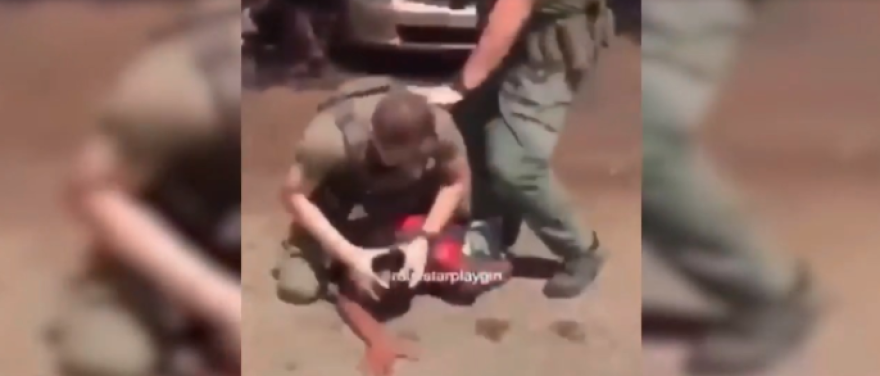
Broward County Public Schools spent $50.6 million on safety and security in 2019-20, with a total budget of about $4.7 billion. Superintendent Runcie, who is Black, referred WLRN’s questions to the Broward Sheriff’s Office, which is the agency that employs the district’s school resource officers.
Gregory Tony is Broward’s first Black sheriff. Republican Gov. Ron DeSantis appointed him to the post last year after suspending the previous sheriff, Israel, over the agency’s mistakes in responding to the Parkland shooting. Tony was re-elected last month.
Tony said school police still carry long rifles, including AR-15s, on campuses, like Olivia remembered seeing shortly after the Parkland shooting. But now they’re instructed to store them rather than carry them around.
Tony said he is disappointed to hear that Black students feel threatened and intimidated by his deputies, and he said he’s trying to improve that. He argued schools need police to protect students from serious threats like shooters, and he said he wants Black kids to feel protected, too.
He recently allocated $1 million of the agency’s budget toward racial equity and implicit bias training.
“As a Black man, I live the injustices,” Tony said. “I felt it as a young kid in the street. I was George Floyd. At 16, I got slammed against the ground. I had a knee on my neck in Philadelphia by a bunch of overly aggressive and abusive officers. Fortunately, I wasn’t choked to death for eight minutes and forty six seconds. But I have never forgotten that experience.
“So I invested a million dollars into that program.”

For student activists in Miami-Dade, this ‘moment’ follows a 15-year fight
A year ago, Miami-Dade County Public Schools Superintendent Alberto Carvalho invited reporters to witness a district police drill: a simulated hostage situation where an armed assailant had trapped students on a school bus near Miami Dade College’s north campus.
The district’s police headquarters was dark, as a dozen floor-to-ceiling screens glowed with the scene playing out five miles away: cops and canines evacuating pretend hostages and arresting a pretend suspect.
Officers seated throughout the command center communicated with those on location using walkie talkies.
“We have the suspect in custody,” an officer radioed in. “We are evacuating the bus.”
Carvalho narrated some context: “What you’re seeing here in high definition is being picked up by a camera at Traz Powell Stadium more than a quarter mile away from the site. The technology is here, the resources are here — the likes of which we’ve never had in this school system or, quite frankly, any other school system across the country.”

Carvalho, who is Hispanic and not Black, has argued those law enforcement resources would help prevent another tragedy like what happened in Parkland.
Student activists who have long fought to get rid of police in Miami-Dade schools see something else: a lot more than the one officer per campus that’s required by law — and a lot of money that could be spent on mental health resources instead.
The district’s $5.4 billion budget in 2019-20 included about $53.4 million for police and security. Spending on mental health was $8.4 million. That will jump to $11.3 million for the current school year because of an increase in state funding.
Power U, a youth empowerment group that supports student activists in Miami-Dade, hosted virtual webinars and phone bank events throughout the summer to mobilize a renewed push for getting police out of schools.
“For the past 15 to 16 years, we’ve been asking to defund police officers. We’ve been asking to have mental health. We’ve been asking for that,” said Keno Walker, a Black staff organizer for Power U who started with the group when he was 13 — then himself a student in the district.
“And now, in this moment, the world is asking for it,” he said. “Don’t be left behind.”
During one recent webinar, a smaller group within Power U that members call “the CNC” — the Counselors Not Cops Committee — listened to recordings of Carvalho’s past statements about the district’s spending on school police and mental health, practicing rebuttals. They crafted speeches to read to school board members during upcoming budget hearings.
“A lot of the narrative that we want to create now — it’s about shaming them for lying to us,” Walker said to about 17 people gathered for the Zoom meeting. “They are like, ‘Oh, you know, we don’t have any power. This is state mandated. We gotta do it.’ But it’s not true.”
It is true that the district must have a police officer on every school campus. Power U argues the Miami-Dade district is going above and beyond the state mandate.
The district has its own police agency, which student activists believe is an unnecessary duplication of the county’s department. Miami-Dade Schools Police is the largest school district police force in the country, with nearly 500 officers. There’s a canine unit, a bicycle unit, a high-tech surveillance infrastructure and a team of investigators. Schools have other security staff, as well.
“We are demanding that money that goes into policing — that money should be moved into mental health coordinators that are at the school each day, all day,” Walker said during the recent webinar.
Carvalho did not agree to an interview for this story. His office sent a statement from the district’s police chief.
“Miami Dade Schools Police Department School Resource Officers are trained to provide the necessary support for children in an effort to guide them as needed, always utilizing arrest as an ultimate last resort,” Chief Edwin Lopez, who is Hispanic and not Black, said in the statement.
He added the training his officers receive equips them with “a wide range of necessary tools to be effective, compassionate and empathetic law enforcement officers.”
“SROs serve in a variety of roles within a school setting, including as coaches, counselors, guardians and mentors,” Lopez said.

The ACLU of Florida and the Southern Poverty Law Center have consistently opposed increasing the police presence in Florida schools and allowing some teachers and other staff to be armed, arguing the changes imposed after the Parkland shooting would hurt students of color in particular.
The Legislature enacted these changes in part based on recommendations from the Marjory Stoneman Douglas High School Public Safety Commission, which was created to investigate the Feb. 14, 2018, massacre. During a late 2018 interview with WLRN, the chair of the commission responded to advocates’ concerns that teachers carrying guns could lead to Black kids getting shot at school.
“I don’t even know where to begin with that. I’m not going to address that. I don’t think that merits discussion,” Bob Gualtieri, who is white, the commission’s leader and also the sheriff in Pinellas County, said during the interview. “There’s no basis for that. So I’m not going to even entertain that type of a question.”
Following the police killings of Floyd, Breonna Taylor in Kentucky and the more recent shooting of Jacob Blake in Wisconsin, the renewed fervor of Black Lives Matter protesters creates an opportunity for civil rights groups in Florida, they hope.
“It’s nice to see the environment shift,” said Michelle Morton, research coordinator and policy counsel for the ACLU of Florida. She is white.
The group will lobby state lawmakers to repeal the mandate for a police officer or armed guard on every school campus. Short of that, the group is hoping for an amendment to allow school districts more flexibility.
“For instance, a school district could just increase patrols around the school … to make sure that police are close by if something happens on campus, but not integrated into the schools,” Morton said.
The ACLU of Florida funded the new UF study examining policing in schools. Curran, the researcher, said his findings support giving local education leaders more control in determining how they protect students, remarking it could come at a convenient time since school districts are facing budget shortfalls related to COVID-19.
“There’s a real need for policymakers in the state to think critically about whether we are striking the right balance between safety and potential unintended consequences of having police in schools,” Curran said.
“So I would recommend that we think about revisiting the law and consider whether we should be returning some of that autonomy to districts and schools to make decisions about whether armed individuals, and particularly police officers, are an appropriate component of their school and environment,” he said.
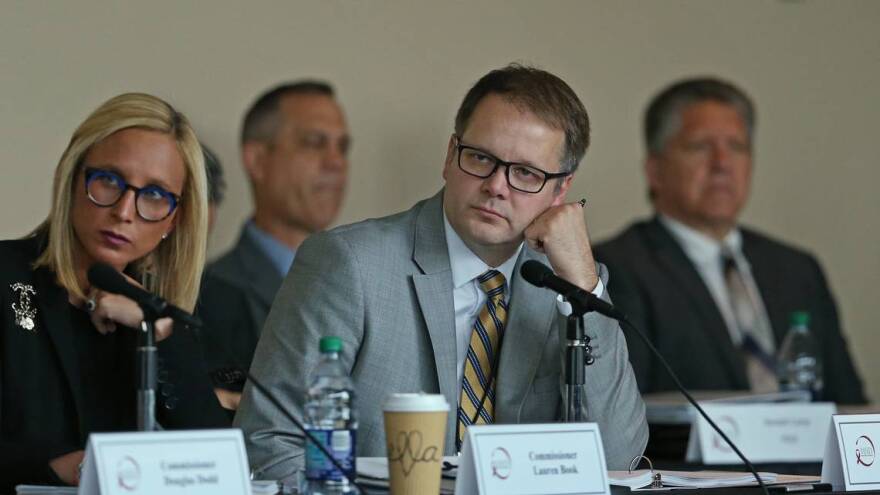
But mass shootings happen fast. Ryan Petty’s 14-year-old daughter Alaina was killed at Stoneman Douglas, and he worries if officers aren’t on campus, dozens of students could be injured or killed while waiting.
Petty is white and now sits on the state Board of Education. He recently wrote op-eds for Newsweek and CNN urging school districts not to abandon their relationships with police departments.
“Look, I’m a father that lost a daughter. And I can say the words: these are low probability events. But they’re high impact,” Petty said. “And so we want to prevent those, and we want to mitigate those as much as possible.”
He said school resource officers are the ones to do that — even though, he acknowledges, the officer assigned to Stoneman Douglas didn’t go in during the shooting there.
“When I look at the responses on social media, the biggest criticism I get personally [from] the folks that disagree with my position — they attack me by saying, ‘How can you advocate for SROs? Look at what happened in your own personal example.’
“The SRO [Scot Peterson] stood outside my daughter’s school for 48 minutes.”
That, Petty said, isn’t an argument for no police officers in schools — but for better ones.
Feature Photo: Black student activists — Joy, holding the megaphone, and Olivia, behind her — participate in a Black Lives Matter protest in Weston in June. The 17-year-olds are among the young people pushing to get police out of schools in South Florida. WLRN is not using their last names because they’ve received online threats. Gerald Albert III/WLRN



